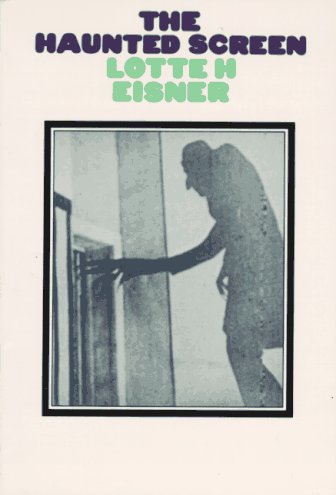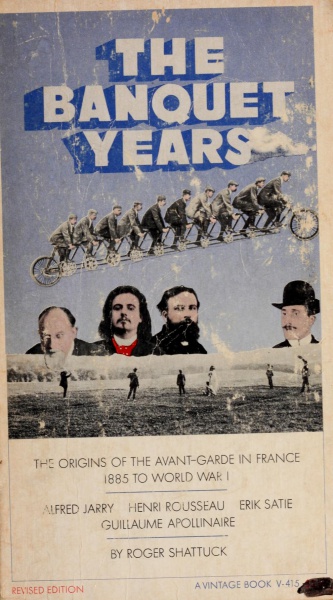Lotte H. Eisner: The Haunted Screen: Expressionism in German Cinema and the Influence of Max Reinhardt (1952/1969)
Filed under book | Tags: · 1910s, 1920s, cinema, expressionism, film, film criticism, film history, germany, romanticism, theatre

The expressionist era of German cinema began at the end of the First World War and ended shortly after the coming of sound. From The Cabinet of Dr. Caligari onwards the principal films of this period were characterized by two influences: literary Expressionism, and the innovations of the theatre directors of this period, in particular Max Reinhardt. This book demonstrates the connection between German Romanticism and the cinema through Expressionist writings. It discusses the influence of the theatre: the handling of crowds; the use of different levels, and of selective lighting on a predominately dark stage; the reliance on formalized gesture; the innovation of the intimate theatre. Against this background the principal films of the period are examined in detail. The author explains the key critical concepts of the time, and surveys not only the work of the great directors, such as Fritz Lang and F. W. Murnau, but also the contribution of their writers, cameramen, and designers.
First published as L’Écran démoniaque. Influence de Max Reinhardt et de l’Expressionisme, 1952; revised 1965.
Translated by Roger Greaves
Publisher Thames and Hudson, London, 1969
360 pages
via knappen
Review (Richard B. Byrne, Cinema Journal, 1970)
PDF (116 MB)
Comment (0)Reyner Banham: Theory and Design in the First Machine Age, 2nd ed. (1960/1967)
Filed under book | Tags: · 1900s, 1910s, 1920s, aesthetics, architecture, art, art history, avant-garde, bauhaus, de stijl, design, design history, functionalism, futurism, history of architecture, industrial design, machine, technology

First published in 1960, Theory and Design in the First Machine Age has become required reading in numerous courses on the history of modern architecture and is widely regarded as one of the definitive books on the modern movement. It has influenced a generation of students and critics interested in the formation of attitudes, themes, and forms which were characteristic of artists and architects working primarily in Europe between 1900 and 1930 under the compulsion of new technological developments in the first machine age.
Publisher Praeger, New York and Washington, 1960
Second edition, 1967; Second printing, 1970
338 pages
Review (Robert Gardner-Medwin, The Town Planning Review, 1961)
Review (Dennis Young)
Review (Caroline S. Lebar, 2012)
Review (of the 2009 French edition, Hugues Fontenas, Critique d’art, 2010, in French)
Commentary (Gillian Naylor, Journal of Design History, 1997)
Commentary (Nigel Whiteley, 2005)
PDF (50 MB, no OCR)
Comment (0)Roger Shattuck: The Banquet Years: The Origins of the Avant-Garde in France, 1885 to World War I., Rev. ed. (1955/1968)
Filed under book | Tags: · 1880s, 1890s, 1900s, 1910s, absurd, anarchism, art, art history, avant-garde, cubism, dada, dreams, france, literature, logic, montage, music history, painting, pataphysics, poetry, theatre, typography

In this book Roger Shattuck portrays the cultural bohemia of turn-of-the-century Paris who carried the arts into a period of renewal and accomplishment, and laid the ground-work for Dada and Surrealism.
“…Then came the idea–a kind of gambler’s hunch–that the trio Rousseau-Satie-Apollinaire represented several significant aspects of the period and could reveal them better than any single figure. The idea would not die. [..] Jarry had forced his way into the group and established himself close to the center of things. He helped clarify my underlying subject: how the fluid state known as bohemia, a cultural underground smacking of failure and fraud, crystallized for a few decades into a self-conscious avant-garde that carried the arts into a period of astonishingly varied renewal and accomplishment. [..] An enormous amount has been written on this era and these men since the first edition of this book in 1958. I have taken account of some of it by changing those passages where new facts have come to light.” (from the Preface to this edition)
First published in 1955
Publisher Vintage Books, 1968
397 pages
Review (Alfred Kazin, The Reporter, 1958)
Review (Sidney Tillim, College Art Journal, 1959)
Review (Justin O’Brien, The Saturday Review, 1958)
PDF (115 MB, no OCR)
Comment (0)
